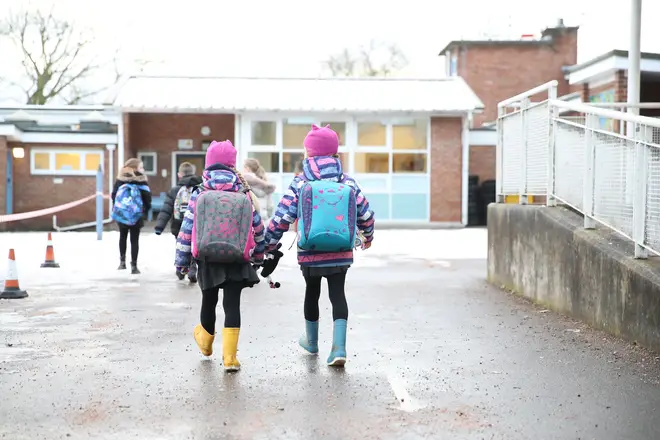
Nick Ferrari 7am - 10am
1 March 2021, 14:06 | Updated: 1 March 2021, 15:36

School staff are not at a higher risk of Covid-19 infection than other working-age adults in their local communities, new figures suggest.
Around 14.99% of school staff tested positive for coronavirus antibodies in December, which indicate a past infection, lower than the estimate of 18.22% for working-age adults, according to a small study of schools.
The survey from the Office for National Statistics (ONS) also suggests the proportion of staff who tested positive for Covid-19 antibodies was 14.61% of primary staff, compared with 15.72% of secondary staff.
Read more: Search under way for missing patient in England with Brazilian Covid strain
The findings come a week before all pupils in England are set to return to class after months of remote learning.
School leaders and teachers have been left "disappointed" after Government advisers decided against prioritising school staff in "crowded" classrooms in the next phase of the Covid-19 vaccine rollout.

Teacher and activists urges Govt not to make a mistake with schools
But a leading Public Health England (PHE) expert said that the country is now in a "much better place" to reopen schools to children during the pandemic.
Dr Shamez Ladhani, a PHE consultant epidemiologist and the study's chief investigator, said it was "extremely reassuring" that teachers do not appear to be at a higher risk of infection than working people of the same age.
In a briefing with reporters, Dr Ladhani said: "I think where we are now is in a really amazing place for reopening schools the right way.
"The country is still in lockdown, the infection rates are falling very, very rapidly, community infection and transmissions are going to be very low when they go back to school, and we're not sending people back out into town because we want the kids to be safe."
But he acknowledged that the Covid-19 reproduction number, or R value, may still increase when schools reopen.
Dr Ladhani said: "At the end of the day it's very, very dependent on community infection rates as to what happens with schools.

Vaccines Minister explains details behind the new Covid strain
"It's not just about the schools. It's about going to schools, it's about parents actually using public transport to get their children to schools, it is about meeting and picking them up so the whole process of schooling comes with a small risk.
"It would be very naive to think that opening schools will not result in any changes in R rates or infection rates, but the bottom line is that the benefits of bringing children back to school far outweigh any risks that we see with Covid."
The Schools Infection Study, from PHE, the ONS and the London School of Hygiene & Tropical Medicine (LSHTM), released on Monday, tested staff and pupils in 121 schools at least once over a few days in early December.
Overall, 12,203 school staff and pupils took part in the study on school sites between December 2 and 10.
Children and staff displaying symptoms would have been expected to be off school and self-isolating.
The study suggests that the proportion of participating staff and pupils who were positive for Covid-19 was lower than the surrounding community.
In secondary schools, 1.22% of pupils and 1.64% of staff overall tested positive for current infection, while in primary schools, 0.94% of pupils and 0.99% of staff tested positive for current infection.
But researchers said differences between primary and secondary schools were not statistically significant, and they stressed that the data collected in the study was not representative of all schools in England.
The data included 80 secondary and 41 primary schools in 15 local authorities.
Professor Sinead Langan, co-chief investigator of the study at LSHTM, said: "These findings show that some individuals attending schools have Covid-19 infections and therefore there is potential for transmission.
"However, it is still hard to say whether this infection is occurring within the schools or in the wider community.
"More investigation is needed to measure the tangible effect of school control measures implementations. The effect of the recently introduced twice weekly home tests on infection prevalence within schools should also be carefully evaluated."